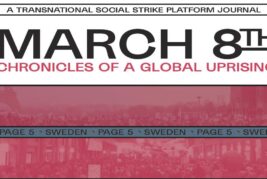
by TRANSNATIONAL SOCIAL STRIKE PLATFORM
Download the whole journal at this link: https://www.transnational-strike.info/app/uploads/2020/12/TSSJ-03_Power-Upside-Down.pdf
The first global women’s strike on March 8th 2017 was an unprecedented experience, with the ability to catalyze a moment of exceptional intensity, synthesizing women’s mobilizations against violence and oppression across the world. Accounts and experiences from that strike were collected in our first reader. As Transnational Social Strike Platform, we find that the astonishing circulation capacity of the strike, and its social and transnational dimension, confirm its potential to be the political pivot of a new global movement. By bringing the fight against patriarchal violence both into the work-place and into society by utilising the strike as political refusal of violence and exploitation, women have established unexpected connections between different subjects and fields of struggle. This mobilisation proved not to be a mere isolated experiment, but rather opened up a field of possibility that resulted in a new call for a global strike on March 8th 2018. This second date is considered, not as a recurring ritual, but more accurately as a sign of the persistence of the strike. On these grounds and shared perspective of struggle, we invited women from different countries between Europe and the Americas to discuss the ways in which they are approaching the strike now.
The contributions from Spain, Italy, Sweden, UK, US and Argentina underscore a keen awareness of being part of a global process of uprising. This reader, therefore, is not simply a chronicle, summing up local experiences, but has the intent and aim to deepen the process and prospect of the feminist strike, which is triggering new opportunities of initiative and organization in each various context. The decision to publish it before the 8th of March is an attempt to think together, from different angles, about the common political challenges faced by all of those taking part in it. How do we carry the possibility offered by the global women’s strike to its full potential and allow it to overflow into our reality? How do we struggle against those who undermine it by declaring it as impossible or “not real”, or those who claim that we are downgrading the strike form? How do we envision the feminist strike as a possibility and project for fighting back against the global neoliberal regime of exploitation and oppression? How do we organize our political communication and transnational infrastructure in order to allow the effects of the strike to be as widespread and long-lasting as possible?
The process between the events
The comrade from Ni una menos Argentina states that “The time from one date to another is not empty”, and this March 8th we see a clear sign of what it means for the strike to be a process, and not simply an event. Thanks to this process, and to the force of a global mass mobilisation, millions of women acquired the strength to speak out and refuse patriarchal violence. The huge feminist marches and demonstrations all around the world encouraged and supported those who have individually chosen to denounce sexual violence and harassment. The incredible flow of stories circulated under the hashtag #metoo is the effect of a collective accumulation of power. Nonetheless, it does not automatically result into a step closer towards a shared and increased collective initiative and organization. The question we are confronting, therefore, is how to be part of this flow, by preventing its neutralization through the neoliberal logics of individualization and the institutional mirroring of cries and redressing of the issue. The case of Sweden presented here is particularly revealing, because the #metoo experience had a certain impact there, while the women’s strike has not yet made inroads. By pointing at the horizon of a radical “shift of power”, the strike reveals itself to be a threat for an “institutional feminism” that is unable to see the global and systemic character of women’s oppression. There is still a lingering hope placed in a possible local or national public intervention to be able to redress it by decree. The global element of the strike allows for a process with a double awakening. First, it provides the possibility to enter the field of struggle not just as mourning victims, or simply as subjects waiting to be recognized or compensated, but as political subjects, taking the lead of a struggle against neoliberalism (which seemed impossible until women stood up against it). Secondly, it obligates us to think about how to assume a global perspective without ignoring the persistence of local or regional differences. As the Swedish comrades’ reference to the war fought by women in Rojava shows, the importance of not assuming the starting point of a given destination like the seemingly pacified and progressive contexts of the Western, European remains of social democracy, but to instead recognize that neoliberalism is supported on a global level by different intensities of patriarchal violence. The strike, then, should be able to synchronize different conditions and struggles without expecting to homogenize them. Therefore it is crucial for the TSS Platform, that interpolates and works to build a transnational infrastructure able to intensify the circulation of the strike and to provide continuity and a capacity to grow in its political potential.
How to make the strike social
The strike becomes a political mark of a possibility of radicalization and synchronization, opening up an “organizational horizon” that poses precise and inescapable questions in each context. One question already raised by the women’s strike concerns the urgency to find ways to enlarge the strike to reproductive labor, that is to all those activities performed by women in the space of the household, always regarded as «private» and, consequently, unpolitical, as the Spanish women from Marea Granate – Femigrantes observe. The problem is not simply solved by providing visibility to the interruption of domestic work. The stake lies in highlighting the social dimension of reproductive labour itself, to disrupt social reproduction in a wider sense. The target is set on displaying the way social hierarchies and gendered positions are reproduced through sexual violence, harassment in the workplace, and the sexual division of labor in all spheres. To socialize the strike means therefore to detect and fight the connection between patriarchal violence and exploitation which is at the core of neoliberal society. The strike is made social when it aims to hit the institutional and social processes of hierarchisation – the processes that intensify precarity by producing isolation and fragmentation. Thus, the different practices and multiple ways to participate in the strike that groups are employing in all countries do not reduce the strike to a symbolic action. Rather, they multiply attempts to politicise women’s position within society, bringing the “margins to the centre” as the Women’s Strike Assembly UK comrades state. A clear example of this ‒ emerging from various contributions collected in this reader ‒ is the attempt to include the struggle against racism as a decisive feminist stance inscribed in the process of the strike. Migrant women everywhere are faced with many forms of sexual abuse throughout their journey for freedom, while at the same time the precarious status imposed by the residence permit turns them into a more exploitable labour force. The intersectional approach highlighted by many contributions appears to be not so much the starting point of the struggle, but rather the effect of the struggle itself. The differences of the subjects involved in the process are not relevant as fixed identities, but in the light of their politicisation, that occurs in the very moment in which their function in the reproduction of an overall system of oppression and exploitation is exposed and contested. Accordingly, we may say that the strike becomes social when it produces a political connection among different subjects by politicising the general effects of specific conditions. This is the horizon and the possibility pointed out by the feminist strike – when the mourning turns into struggle and the claim to smash patriarchy aims to be also a lever for overturning neoliberalism as a global order.
From global feminism to the strike and return
The women’s strike “must account for multiple labour realities that escape the borders of waged and unionized work”, as the women from Ni una menos Argentina say. It requires a broadening of the notion of strike so as to include unpaid, informal, migrant and irregular labour. “When the strike ceases to be the exclusive prerogative of unions […] it stops being an order to which one simply knows how to comply or adhere”. As a matter of fact, just because the unions reclaim the strike as an exclusive prerogative, women everywhere have to fight in order to gain their support, which is in many ways necessary in order to conquer the real possibility of interrupting production and involving as many workplaces as possible. What is clear, however, is also the way in which the feminist use of the strike is exposing and pointing out all the limitations of the trade-unions who are restricted to labor disputes, while at the same time highlighting the possibility of bringing strike back to the centre, after years in which it has been practically deprived of all its power and effectiveness by the neoliberal organization of labour. In other words, the women’s strike lifts the possibility to set a new trend also in labor struggles. This is quite clear from both the contributions of the International Women’s Strike US comrades, which claim the power to strike in a context where labour legislation is particularly restrictive, and of Women’s Strike Assembly in the UK, where the legal right to strike has been further restricted since 2016. This year dozens of organizations and base unions are endorsing the strike, reacting to years of decaying rights for workers and invoking the strike “as a necessary and political form of action that is often seen as an impossibility and therefore a privilege”. In Spain the autonomous, global dimension and massive character of the process has forced the major trade unions to endorse the strike. It is clear, then, that the question of how to strike is not just technical, but rather political, as stated by the Italian comrades of Non una di Meno, dealing with a partial legal ban due to proximity of the strike with the national elections. The feminist strike is therefore an occasion to rethink the strike as the expression of a collective insubordination against the overall conditions of precarization, because it points at the necessity of breaking isolation and overcoming the weakness to which precarization condemns labour as such. With this reasoning, the International Women’s Strike US calls for a feminism of the 99%, bringing the slogan of the Occupy movement back in. By claiming to be feminist, this 99% does not neutralize the differences that crisscross the working class, but rather catalyses them, pointing at the possibility for the women’s strike to be at the forefront of a general struggle, inciting a wider movement of insubordination.
Besides implying a general transformation of the strike, this global process of uprising ushers in a transformation of feminism as well. The feminist strike presents itself not as a separatist or identity-based fight of women’s and lbgtqi+ subjects, but rather as a struggle able to involve migrants, precarious and industrial workers of all genders turning the refusal of patriarchal violence into the shared starting point – a fight against capitalism, racism and the violence of this society. In this perspective, a systematic work of connections which gives voice to these transnational processes between the events, fostering the social dimension of the strike, and imposing a general reassessment of the very practice of the strike is increasingly necessary. The strike is not a “given”, in each context, it needs to be defended, accomplished, fostered, vocalized – and contagious. In line with this, the contributions presented here are insights of the chances and challenges of the global process of uprising, betting on the strike, knowing that “the strike’s message is the strike itself, because it shows where the power lies. It is a demonstration of power that we see necessary to maximise our power”.





